Types of Seagulls

The American herring gull or Smithsonian gull (Larus smithsonianus or Larus argentatus smithsonianus) is a large gull that breeds in North America, where it is treated by the American Ornithologists' Union as a subspecies of herring gull (L. argentatus).

The Andean gull (Chroicocephalus serranus) is a species of gull in the family Laridae. As is the case with many gulls, it has traditionally been placed in the genus Larus. It is found in the Andes in mountainous regions of Argentina, Bolivia, Chile, Colombia, Ecuador, and Peru.
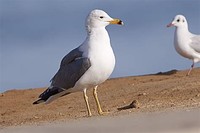
The Armenian gull nests beside mountain lakes in Georgia, Armenia, Turkey and western Iran. The largest colonies are at Lake Sevan and Lake Arpi in Armenia. It is a partial migrant with many birds wintering on the coasts of Turkey, Lebanon and Israel.

The Audouin's gull (Ichthyaetus audouinii) is a large gull restricted to the Mediterranean and the western coast of Saharan Africa and the Iberian peninsula. The genus name is from Ancient Greek ikhthus, "fish", and aetos, "eagle", and the specific audouinii and the English name are after the French naturalist Jean Victoire Audouin.
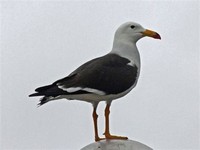
Belcher's gull (Larus belcheri), also known as the band-tailed gull, is a bird in the family Laridae found along the Pacific coast of South America. It formerly included the very similar Olrog's gull as a subspecies, but that bird occurs on the Atlantic coast of South America and is now accepted as Larus atlanticus.

The black-billed gull (Chroicocephalus bulleri), also known as Buller's gull, is a species of gull in the family Laridae. It is found only in New Zealand.

The black-headed gull (Chroicocephalus ridibundus) is a small gull that breeds in much of Europe and Asia, and also in coastal eastern Canada. Most of the population is migratory and winters further south, but some birds reside in the milder westernmost areas of Europe.

The black-legged kittiwake (Rissa tridactyla) is a seabird species in the gull family Laridae. This species was first described by Linnaeus in his Systema naturae in 1758 as Larus tridactylus. The English name is derived from its call, a shrill 'kittee-wa-aaake, kitte-wa-aaake'.

The black-tailed gull feeds mainly on small fish, molluscs, crustaceans scraps and carrion. A study analyzing the identifiable parts of gull excreta in Korea found that 19.1% consisted of the remains of fish, 3.3% of crustaceans, and 3.3% of land insects. The species often follows ships and commercial fishing fleets. It also steals food from other seabirds. It is a colonial nester, with colonies forming in mid-April. 2–3 eggs are laid by early June. Incubation lasts approximately 24 days.

Bonaparte's gull is a member of the gull family Laridae found mainly in northern North America. At 28 to 38 cm in length, it is one of the smallest species of gull. Its plumage is mainly white with grey upperparts. During breeding season, Bonaparte's gull gains a slate-grey hood. The sexes are similar in appearance.

Bonaparte's gull is among the smallest of the gull species; only little gull and Saunders's gull are smaller. Adults range from 28 to 38 cm (11 to 15 in) in length, with a wingspan of 76–84 cm (30–33 in) and a body mass of 180–225 g (6.3–7.9 oz).

The brown-headed gull (Chroicocephalus brunnicephalus) is a small gull which breeds in the high plateaus of central Asia from Tajikistan to Ordos in Inner Mongolia. It is migratory, wintering on the coasts and large inland lakes of the Indian Subcontinent.

The brown-hooded gull (Chroicocephalus maculipennis) is a species of gull found in Argentina, Brazil, Chile, the Falkland Islands, and Uruguay. Its specific epithet, maculipennis, means 'spotted wings' (macula + penna). It is a white bird with a brown head and red beak and feet.

The brown-hooded gull (Chroicocephalus maculipennis) is a species of gull found in Argentina, Brazil, Chile, the Falkland Islands, and Uruguay. Its specific epithet, maculipennis, means 'spotted wings' (macula + penna). It is a white bird with a brown head and red beak and feet.

The California gull (Larus californicus) is a medium-sized gull, smaller on average than the herring gull but larger on average than the ring-billed gull, though it may overlap in size greatly with both.

The Caspian gull is a large gull and a member of the herring and lesser black-backed gull complex. The scientific name is from Latin. Larus appears to have referred to a gull or other large seabird, and cachinnans means "laughing", from cachinnare, "to laugh".

The Caspian gull is a large gull and a member of the herring and lesser black-backed gull complex. The scientific name is from Latin. Larus appears to have referred to a gull or other large seabird, and cachinnans means "laughing", from cachinnare, "to laugh".

The common gull (Larus canus) is a medium-sized gull that breeds in northern Asia, northern Europe, and northwestern North America. The North American subspecies is commonly referred to as the mew gull, although that name is also used by some authorities for the whole species.

One day, a seagull landed in Kelly the dolphin’s pool. She obediently brought it to her trainer, who rewarded her with extra fish. If this was some other animal, the story might have ended there. But Kelly had a talent for math—and manipulation. She realized that gulls were worth more than trash, and that one gull was worth more than one fish.

The dolphin gull (Leucophaeus scoresbii), sometimes erroneously called the red-billed gull (a somewhat similar but unrelated species from New Zealand), is a gull native to southern Chile and Argentina, and the Falkland Islands.

The European herring gull (Larus argentatus) is a large gull (up to 26 in (66 cm) long). One of the best known of all gulls along the shores of western Europe, it was once abundant. It breeds across Northern Europe, Western Europe, Central Europe, Eastern Europe, Scandinavia and the Baltic states.

A small, black-headed gull of the prairies, the Franklin's Gull is a common sight in the interior of North America, following plows to eat exposed worms, insects, and mice.

The glaucous gull (Larus hyperboreus) is a large gull, the second largest gull in the world which breeds in Arctic regions of the Northern Hemisphere and winters south to shores of the Holarctic. The genus name is from Latin Larus which appears to have referred to a gull or other large seabird.

The glaucous-winged gull (Larus glaucescens) is a large, white-headed gull. The genus name is from Latin Larus which appears to have referred to a gull or other large seabird. The specific glaucescens is New Latin for "glaucous" from the Ancient Greek, glaukos.

The glaucous-winged gull (Larus glaucescens) is a large, white-headed gull. The genus name is from Latin Larus which appears to have referred to a gull or other large seabird. The specific glaucescens is New Latin for "glaucous" from the Ancient Greek, glaukos.
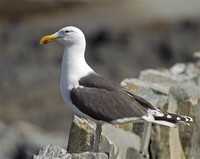
The great black-backed gull (Larus marinus), mistakenly called greater black-backed gull by some, is the largest member of the gull family. It breeds on the European and North American coasts and islands of the North Atlantic and is fairly sedentary, though some move farther south or inland to large lakes or reservoirs.
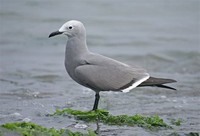
Gulls are typically medium to large birds, usually grey or white, often with black markings on the head or wings. They typically have harsh wailing or squawking calls; stout, longish bills; and webbed feet. Most gulls are ground-nesting carnivores which take live food or scavenge opportunistically, particularly the Larus species.

The grey-headed gull (Chroicocephalus cirrocephalus), also known as the grey-hooded gull, is a small gull which breeds patchily in South America and Africa south of the Sahara.
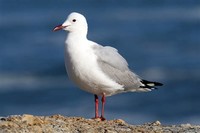
The Hartlaub's gull or king gull, (Chroicocephalus hartlaubii) is a small gull, which is a non-migratory breeding resident endemic to the Atlantic Ocean coastline of South Africa and Namibia. Although it is predominantly coastal or estuarine, it is not a pelagic species, and is rarely seen at sea far from land.

The Heermann's gull (Larus heermanni) is a gull resident in the United States, Mexico and extreme southwestern British Columbia, nearly all nesting on Isla Rasa in the Gulf of California. They are usually found near shores or well out to sea, very rarely inland.

What is the difference between “gull” and ... tells me that the proper term is gull, ... but practically everyone calls them seagulls. – ssav Oct 22 ...

The Iceland gull (Larus glaucoides) is a medium size gull which breeds in the Arctic regions of Canada and Greenland; although not in Iceland (as its name suggests), where it is only seen during winter.

The kelp gull (Larus dominicanus), also known as the Dominican gull, is a gull which breeds on coasts and islands through much of the southern hemisphere.

The laughing gull (Leucophaeus atricilla) is a medium-sized gull of North and South America. The genus name Leucophaeus is from Ancient Greek leukos, "white", and phaios, "dusky". The specific atricilla is from Latin ater, "black", and cilla, "tail".

The lava gull (Leucophaeus fuliginosus), also known as the dusky gull, is a medium-sized gull and a member of the "hooded gull" group. It is most closely related to the Laughing gull and Franklin's gull and is the rarest gull in the world.

Common across Europe, the Lesser Black-backed Gull is an uncommon, but regular visitor to eastern North America. Its occurrence on this continent increased dramatically over the last third of the 20th century.

The little gull (Hydrocoloeus minutus or Larus minutus), is a small gull that breeds in northern Europe and Asia. The genus name Hydrocoloeus is from Ancient Greek hudro, "water", and koloios, a sort of web-footed bird.
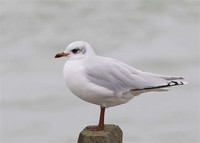
The Mediterranean gull is slightly larger and bulkier than the black-headed gull with a heavier bill and longer, darker legs. The breeding plumage adult is a distinctive white gull, with a very pale grey mantle and wings with white primary feathers without black tips.

The Mediterranean gull is slightly larger and bulkier than the black-headed gull with a heavier bill and longer, darker legs. The breeding plumage adult is a distinctive white gull, with a very pale grey mantle and wings with white primary feathers without black tips.

Olrog’s gull is a large gull with a white head, neck, rump, breast and belly. The back and wings are black except for a white trailing edge to the wings. The tail is white with a broad black band at the back. The beak is yellow with a black band and red tip. The eyes are brown with a red orbital ring and the legs and feet are dull yellow.

The Pacific gull (Larus pacificus) is a very large gull, native to the coasts of Australia. It is moderately common between Carnarvon in the west, and Sydney in the east, although it has become scarce in some parts of the south-east, as a result of competition from the kelp gull, which has "self-introduced" since the 1940s.

The Pallas's gull or great black-headed gull (Ichthyaetus ichthyaetus) is a large gull.As is the case with many gulls, it has traditionally been placed in the genus Larus. ...

Click here for more information about the Red List categories and criteria Justification of Red List category This species has an extremely large range, and hence does not approach the thresholds for Vulnerable under the range size criterion (Extent of Occurrence <20,000 km 2 combined with a declining or fluctuating range size, habitat extent ...

The red-legged kittiwake (Rissa brevirostris) is a seabird species in the gull family Laridae. It breeds in the Pribilof Islands, Bogoslof Island and Buldir Island in the Bering Sea off the coast of Alaska, and the Commander Islands, Russia and spends the winter at sea.

The relict gull or Central Asian gull is a medium-sized gull. It was believed to be an eastern race of the Mediterranean gull until 1971 and was traditionally placed in the genus Larus.
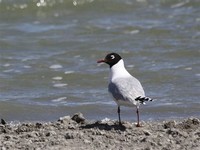
The relict gull or Central Asian gull is a medium-sized gull. It was believed to be an eastern race of the Mediterranean gull until 1971 and was traditionally placed in the genus Larus.

The ring-billed gull (Larus delawarensis) is a medium-sized gull. The genus name is from Latin Larus which appears to have referred to a gull or other large seabird. The specific delawarensis refers to the Delaware River.

Large white-headed gull is used to describe the 18 or so herring gull-like species from California gull to lesser black-backed gull in the taxonomic list below.

[Typical gull repetitive bugling call] Gulls seem so much a part of the sea that we often just call them “seagulls,” a colloquial title for these graceful, ubiquitous creatures. Although a fixture on many beaches, most gulls aren’t truly seafaring birds.

What is the difference between “gull” and ... tells me that the proper term is gull, ... but practically everyone calls them seagulls. – ssav Oct 22 ...